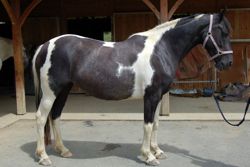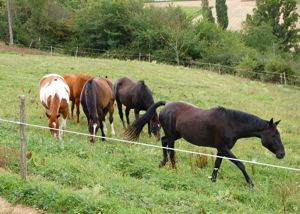

What Do We Achieve When We Train A Horse?Spotlight On Training: The Real Goal of Training Like most things in life, there seem to be two different roads we can take when we start off on the training voyage with our horse. Either we can take the road where the importance of appearance is everything, because our ultimate goal is to produce an image which we hope will win recognition and approval, or we can take the road along which we choose to find and resolve the deficiencies in ourselves and our horse, and in doing this discover what a real relationship is. Training a horse in order to produce the image expected in modern competition circles often resembles in many ways the conditioning of animals in a circus. Originally, dressage movements were developed as exercises to be used at the discretion of the rider to gymnasticize, i.e strengthen and supple the horse, so that he could carry a rider elegantly and comfortably without sustaining physical damage. The common practice these days is to view the performance of dressage movements as the end and not the means, and in this they have taken on the status of tricks, because they are performed for the sake of being performed. The widespread expectations placed on riders interested in dressage and training horses to conform to this system or fail, is damaging the integrity of the horse world. Why is going down this road missing the point? Because if we concern ourselves only with getting our horse to 'do the movements' then we are not actually listening and feeling our horse in order to understand what his individual needs are at every stage of training, and every moment of a riding session. Only by becoming aware of these individual needs can we truly connect physically and mentally with our horse, as we address the issues as they are, without trying to cover them up or push past them. What is required to listen to and feel our horse? simply that riders take responsibility for their own development. Just as a trailer which carries an uneven load will compensate by moving unevenly, if we are uneven and insensitive riders, so our horses must reflect that because they have no choice. It may be possible for a riders faults to be absorbed to the point where they are hidden by the ability of a good enough horse - but even super horses can't engage or straighten themselves, and the quality of the connection with any horse comes down to the quality of riding, and the rider's willingness to focus on that. It may sound like the tough option, but in fact any other way to train and ride is so artificial and unrewarding that it requires a continuous hunt for a better horse and another competition to fire up enough motivation to keep going. When the focus is turned on to the exploration of the development of our own qualities as a rider and trainer, and how we can release the potential of any horse, or simply our own unique horse, then the motivation looks after itself.


These two photos show the transformation that it is possible to make in a horse through correct training. This mare has been particularly difficult to train, due to physical and temperamental issues, but rewards have come from slow and careful persistence, along with therapy and a happy lifestyle. The first photo shows her as a 4 year old, in the second she is 11. Obviously she has matured over this time, but the development of her musculature is due to her work in engagement (see photo above). Spotlight on Management: Bringing The Same Values into Horse Care The same principles apply to how we look after our horses as how we train them. If we can look beyond our own limitations and see the deeper truths then we can give our horses the most valuable gift there is, freedom to be themselves. When horses play and have fun in the field they may end up with some bites and look a bit scruffier than if they were standing in a stable all day, but the value they gain for their well-being from this interaction is priceless. We realize that our own horses, who spend as much of their time as possible outside - all year round, may experience as a result slightly more superficial discomfort from weather conditions, flies and so on, but the profound level of happiness they have as a result of their freedom and social interaction greatly outweighs this. Again, we have to look beyond surface appearances to see the deeper truth. In the same way, when we take off their shoes and allow horses to feel their own feet again, they begin to be able to move as they have evolved to over millions of years. Of course there are likely to be problems to overcome, because we have disrupted their natural survival mechanisms, but allowing a horse move with the suppleness and connectedness to the ground only possible without shoes, is a gift beyond value.
New pages on Happy Horse Training: Mark Rashid: Principles in Common Horse Healing Philosophy Horse Behavioural Problems Dressage And Natural Horsemanship - What's The Difference? Click here to return to Happy Horse Training home New! CommentsAnything to say about this page? Leave your comment in the box below. |
Join the Whole Horse Newsletter
HHT's free monthly newsletter giving you wide-ranging and intelligent insights into holistic horsemanship.
Just enter your details below to join.
Free bonus on the riding position with all new subscriptions: Ten Top Tips To Instantly Improve Your Connection With Your Horse.
Train Your Horse
The Holistic Way
How To Train A Horse Without Force is a unique guide to training horses through energetic connection and gymnastic training. Part 1 covers everything on the ground, from handling to the lungeing technique that develops strength, straightness and engagement. Comes with a free eBook supplement on Horse Trauma.
Click here for more details.
Do You Have
A Horse Story
To Share On HHT?
So many people have been through wonderful experiences with horses, whether in training or otherwise. If you've made a change in a horse's life - or one has made a change in yours - tell us about it here.
Learn How To Trim
Your Own Horse's Feet
The Simple Seven-Step Natural Trim is a comprehensive step-by-step guide to a cutting-edge barefoot trim. Click here to find out more.




